music generation
Music generation is the task of generating music or music-like sounds from a model or algorithm.
Papers and Code
Expressive Timing in Hindustani Vocal Music
Mar 27, 2025Temporal dynamics are among the cues to expres siveness in music performance in different cultures. In the case of Hindustani music, it is well known that expert vocalists often take liberties with the beat, intentionally not aligning their singing precisely with the relatively steady beat provided by the accompanying tabla. This becomes evident when comparing performances of the same composition such as a bandish. We present a methodology for the quantitative study of differences across performed pieces using computational techniques. This is applied to small study of two performances of a popular bandish in raga Yaman, to demonstrate how we can effectively capture the nuances of timing variations that bring out stylistic constraints along with the individual signature of a performer. This work articulates an important step towards the broader goals of music analysis and generative modelling for Indian classical music performance.
Tune It Up: Music Genre Transfer and Prediction
Mar 27, 2025Deep generative models have been used in style transfer tasks for images. In this study, we adapt and improve CycleGAN model to perform music style transfer on Jazz and Classic genres. By doing so, we aim to easily generate new songs, cover music to different music genres and reduce the arrangements needed in those processes. We train and use music genre classifier to assess the performance of the transfer models. To that end, we obtain 87.7% accuracy with Multi-layer Perceptron algorithm. To improve our style transfer baseline, we add auxiliary discriminators and triplet loss to our model. According to our experiments, we obtain the best accuracies as 69.4% in Jazz to Classic task and 39.3% in Classic to Jazz task with our developed genre classifier. We also run a subjective experiment and results of it show that the overall performance of our transfer model is good and it manages to conserve melody of inputs on the transferred outputs. Our code is available at https://github.com/ fidansamet/tune-it-up
Engineering Serendipity through Recommendations of Items with Atypical Aspects
May 29, 2025
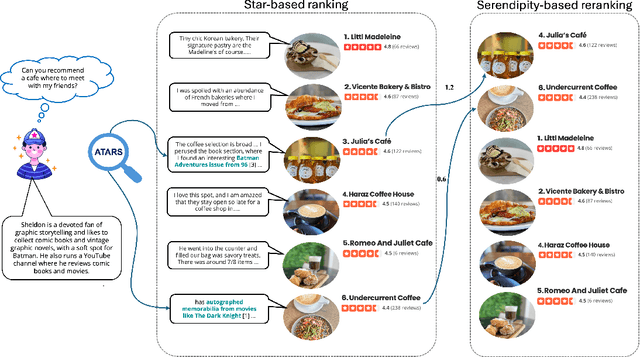


A restaurant dinner or a hotel stay may lead to memorable experiences when guests encounter unexpected aspects that also match their interests. For example, an origami-making station in the waiting area of a restaurant may be both surprising and enjoyable for a customer who is passionate about paper crafts. Similarly, an exhibit of 18th century harpsichords would be atypical for a hotel lobby and likely pique the interest of a guest who has a passion for Baroque music. Motivated by this insight, in this paper we introduce the new task of engineering serendipity through recommendations of items with atypical aspects. We describe an LLM-based system pipeline that extracts atypical aspects from item reviews, then estimates and aggregates their user-specific utility in a measure of serendipity potential that is used to rerank a list of items recommended to the user. To facilitate system development and evaluation, we introduce a dataset of Yelp reviews that are manually annotated with atypical aspects and a dataset of artificially generated user profiles, together with crowdsourced annotations of user-aspect utility values. Furthermore, we introduce a custom procedure for dynamic selection of in-context learning examples, which is shown to improve LLM-based judgments of atypicality and utility. Experimental evaluations show that serendipity-based rankings generated by the system are highly correlated with ground truth rankings for which serendipity scores are computed from manual annotations of atypical aspects and their user-dependent utility. Overall, we hope that the new recommendation task and the associated system presented in this paper catalyze further research into recommendation approaches that go beyond accuracy in their pursuit of enhanced user satisfaction. The datasets and the code are made publicly available at https://github.com/ramituncc49er/ATARS .
A Multimodal Symphony: Integrating Taste and Sound through Generative AI
Mar 04, 2025In recent decades, neuroscientific and psychological research has traced direct relationships between taste and auditory perceptions. This article explores multimodal generative models capable of converting taste information into music, building on this foundational research. We provide a brief review of the state of the art in this field, highlighting key findings and methodologies. We present an experiment in which a fine-tuned version of a generative music model (MusicGEN) is used to generate music based on detailed taste descriptions provided for each musical piece. The results are promising: according the participants' ($n=111$) evaluation, the fine-tuned model produces music that more coherently reflects the input taste descriptions compared to the non-fine-tuned model. This study represents a significant step towards understanding and developing embodied interactions between AI, sound, and taste, opening new possibilities in the field of generative AI. We release our dataset, code and pre-trained model at: https://osf.io/xs5jy/.
FilmComposer: LLM-Driven Music Production for Silent Film Clips
Mar 11, 2025



In this work, we implement music production for silent film clips using LLM-driven method. Given the strong professional demands of film music production, we propose the FilmComposer, simulating the actual workflows of professional musicians. FilmComposer is the first to combine large generative models with a multi-agent approach, leveraging the advantages of both waveform music and symbolic music generation. Additionally, FilmComposer is the first to focus on the three core elements of music production for film-audio quality, musicality, and musical development-and introduces various controls, such as rhythm, semantics, and visuals, to enhance these key aspects. Specifically, FilmComposer consists of the visual processing module, rhythm-controllable MusicGen, and multi-agent assessment, arrangement and mix. In addition, our framework can seamlessly integrate into the actual music production pipeline and allows user intervention in every step, providing strong interactivity and a high degree of creative freedom. Furthermore, we propose MusicPro-7k which includes 7,418 film clips, music, description, rhythm spots and main melody, considering the lack of a professional and high-quality film music dataset. Finally, both the standard metrics and the new specialized metrics we propose demonstrate that the music generated by our model achieves state-of-the-art performance in terms of quality, consistency with video, diversity, musicality, and musical development. Project page: https://apple-jun.github.io/FilmComposer.github.io/
Align Your Rhythm: Generating Highly Aligned Dance Poses with Gating-Enhanced Rhythm-Aware Feature Representation
Mar 21, 2025Automatically generating natural, diverse and rhythmic human dance movements driven by music is vital for virtual reality and film industries. However, generating dance that naturally follows music remains a challenge, as existing methods lack proper beat alignment and exhibit unnatural motion dynamics. In this paper, we propose Danceba, a novel framework that leverages gating mechanism to enhance rhythm-aware feature representation for music-driven dance generation, which achieves highly aligned dance poses with enhanced rhythmic sensitivity. Specifically, we introduce Phase-Based Rhythm Extraction (PRE) to precisely extract rhythmic information from musical phase data, capitalizing on the intrinsic periodicity and temporal structures of music. Additionally, we propose Temporal-Gated Causal Attention (TGCA) to focus on global rhythmic features, ensuring that dance movements closely follow the musical rhythm. We also introduce Parallel Mamba Motion Modeling (PMMM) architecture to separately model upper and lower body motions along with musical features, thereby improving the naturalness and diversity of generated dance movements. Extensive experiments confirm that Danceba outperforms state-of-the-art methods, achieving significantly better rhythmic alignment and motion diversity. Project page: https://danceba.github.io/ .
Learning Nonlinear Dynamics in Physical Modelling Synthesis using Neural Ordinary Differential Equations
May 15, 2025



Modal synthesis methods are a long-standing approach for modelling distributed musical systems. In some cases extensions are possible in order to handle geometric nonlinearities. One such case is the high-amplitude vibration of a string, where geometric nonlinear effects lead to perceptually important effects including pitch glides and a dependence of brightness on striking amplitude. A modal decomposition leads to a coupled nonlinear system of ordinary differential equations. Recent work in applied machine learning approaches (in particular neural ordinary differential equations) has been used to model lumped dynamic systems such as electronic circuits automatically from data. In this work, we examine how modal decomposition can be combined with neural ordinary differential equations for modelling distributed musical systems. The proposed model leverages the analytical solution for linear vibration of system's modes and employs a neural network to account for nonlinear dynamic behaviour. Physical parameters of a system remain easily accessible after the training without the need for a parameter encoder in the network architecture. As an initial proof of concept, we generate synthetic data for a nonlinear transverse string and show that the model can be trained to reproduce the nonlinear dynamics of the system. Sound examples are presented.
Accompaniment Prompt Adherence: A Measure for Evaluating Music Accompaniment Systems
Mar 08, 2025



Generative systems of musical accompaniments are rapidly growing, yet there are no standardized metrics to evaluate how well generations align with the conditional audio prompt. We introduce a distribution-based measure called "Accompaniment Prompt Adherence" (APA), and validate it through objective experiments on synthetic data perturbations, and human listening tests. Results show that APA aligns well with human judgments of adherence and is discriminative to transformations that degrade adherence. We release a Python implementation of the metric using the widely adopted pre-trained CLAP embedding model, offering a valuable tool for evaluating and comparing accompaniment generation systems.
GCDance: Genre-Controlled 3D Full Body Dance Generation Driven By Music
Feb 25, 2025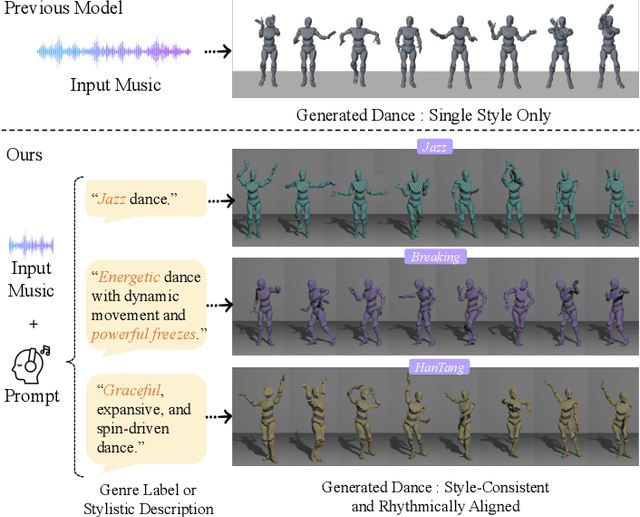
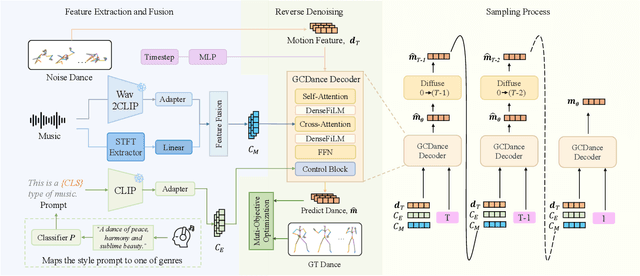
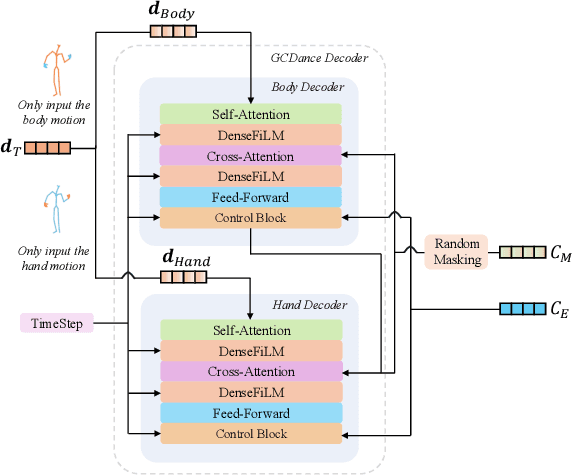
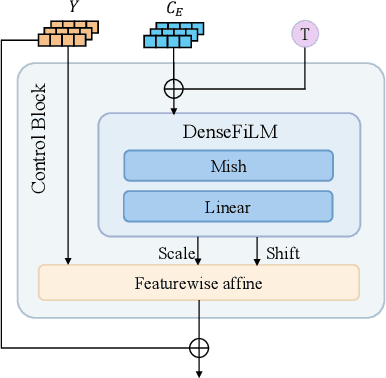
Generating high-quality full-body dance sequences from music is a challenging task as it requires strict adherence to genre-specific choreography. Moreover, the generated sequences must be both physically realistic and precisely synchronized with the beats and rhythm of the music. To overcome these challenges, we propose GCDance, a classifier-free diffusion framework for generating genre-specific dance motions conditioned on both music and textual prompts. Specifically, our approach extracts music features by combining high-level pre-trained music foundation model features with hand-crafted features for multi-granularity feature fusion. To achieve genre controllability, we leverage CLIP to efficiently embed genre-based textual prompt representations at each time step within our dance generation pipeline. Our GCDance framework can generate diverse dance styles from the same piece of music while ensuring coherence with the rhythm and melody of the music. Extensive experimental results obtained on the FineDance dataset demonstrate that GCDance significantly outperforms the existing state-of-the-art approaches, which also achieve competitive results on the AIST++ dataset. Our ablation and inference time analysis demonstrate that GCDance provides an effective solution for high-quality music-driven dance generation.
CrossMuSim: A Cross-Modal Framework for Music Similarity Retrieval with LLM-Powered Text Description Sourcing and Mining
Mar 29, 2025Music similarity retrieval is fundamental for managing and exploring relevant content from large collections in streaming platforms. This paper presents a novel cross-modal contrastive learning framework that leverages the open-ended nature of text descriptions to guide music similarity modeling, addressing the limitations of traditional uni-modal approaches in capturing complex musical relationships. To overcome the scarcity of high-quality text-music paired data, this paper introduces a dual-source data acquisition approach combining online scraping and LLM-based prompting, where carefully designed prompts leverage LLMs' comprehensive music knowledge to generate contextually rich descriptions. Exten1sive experiments demonstrate that the proposed framework achieves significant performance improvements over existing benchmarks through objective metrics, subjective evaluations, and real-world A/B testing on the Huawei Music streaming platform.
 Add to Chrome
Add to Chrome Add to Firefox
Add to Firefox Add to Edge
Add to Edge